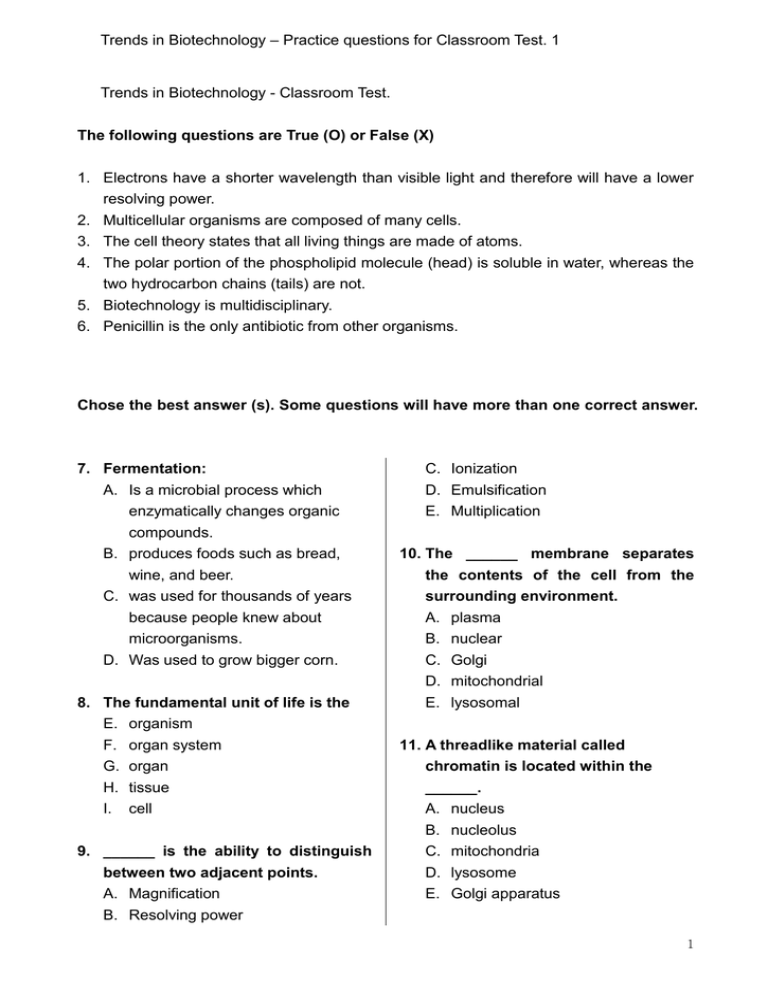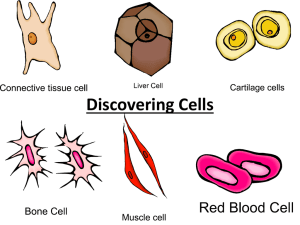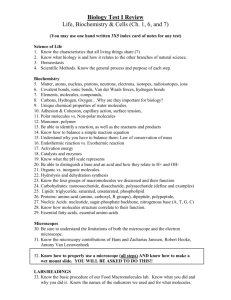Cell theory
advertisement

Trends in Biotechnology – Practice questions for Classroom Test. 1 Trends in Biotechnology - Classroom Test. The following questions are True (O) or False (X) 1. Electrons have a shorter wavelength than visible light and therefore will have a lower resolving power. 2. Multicellular organisms are composed of many cells. 3. The cell theory states that all living things are made of atoms. 4. The polar portion of the phospholipid molecule (head) is soluble in water, whereas the two hydrocarbon chains (tails) are not. 5. Biotechnology is multidisciplinary. 6. Penicillin is the only antibiotic from other organisms. Chose the best answer (s). Some questions will have more than one correct answer. 7. Fermentation: A. Is a microbial process which enzymatically changes organic compounds. B. produces foods such as bread, wine, and beer. C. was used for thousands of years because people knew about microorganisms. D. Was used to grow bigger corn. 8. The fundamental unit of life is the E. organism F. G. H. I. organ system organ tissue cell 9. ______ is the ability to distinguish between two adjacent points. A. Magnification B. Resolving power C. Ionization D. Emulsification E. Multiplication 10. The ______ membrane separates the contents of the cell from the surrounding environment. A. plasma B. nuclear C. Golgi D. mitochondrial E. lysosomal 11. A threadlike material called chromatin is located within the ______. A. nucleus B. nucleolus C. mitochondria D. lysosome E. Golgi apparatus 1 Trends in Biotechnology – Practice questions for Classroom Test. 1 12. ______ are lipids containing phosphorus that are very important in cell membranes. 1. Glycerol 2. Fatty acids 3. Triglycerides 4. Steroids 5. Phospholipids 13. __________ is the commercial use of living organisms or their components to improve animal and human health, agriculture, and the environment. A. Bioconversion B. Biotechnology C. DNA fingerprinting D. Bioremediation 14. The renowned French Chemist __________ eventually established that yeast and other microbes are directly linked to fermentation. A. Louis Pasteur B. Anton van Leeuwenhoek C. Shen Nan D. CGIAR 15. __________ is added to fruit juice to improve taste. A. Lysine B. Methionine C. Cysteine D. Alanine 16. __________ is used in Japan to make bread a more complete protein. A. Cysteine B. Alanine C. Lysine D. Methionine 17. Fermentation has been modified to make: A. glycerol for explosives B. aseptic techniques C. antibiotics D. butanol 18. Development of staining techniques: A. Made it easier to see cell parts with a microscope B. Made the cells pretty colors C. Showed that living things come from other living things D. Showed that cells come from cells 19. Which of these are fluorochromes? A. GFP B. Primary antibodies C. Phalloidin D. Fluorescent protein 20. Which has most magnification? A. Scanning electron microscope B. Transmission electron microscope C. Fluorescent microscope D. Light microscope 21. Indirect immuno-cytochemistry is very sensitive because: A. The primary antibody is recognized by many molecules of the secondary antibody B. A flurorophore can be directly conjugated to the primary antibody C. This techniques uses highly specific binding of an antibody to its antigen 2 Trends in Biotechnology – Practice questions for Classroom Test. 1 D. Fluorescent stains are drugs or D. By measuring the strength and toxins which bind to specific cellular structures and have been made with a fluorescent reporter position of the diffraction pattern we can work back to the structure of the molecule 22. STED-microscopy uses A. The fluorescence of single molecules being turned on and off B. Electrons which have a much shorter wavelength than light C. Many images of the same area 25. It is important to find the structure of bacterial ribosomes because we can: A. Find antibiotics which block the tunnel through which proteins leave the ribosome D. Two laser beams, one to stimulate the fluorescent molecules and the other to cancel out fluorecence B. Find antibiotics which stop the formation of peptide bonds between amino acids C. Find antibiotics which stop the correct translation from RNA into proteins D. Color the proteins blue, or green, and the rRNA molecules orange. 23. Because the cell has many things in it: A. Different reactions and products are localized to different areas B. Molecules are used to organize the cell processes C. Transport in the cell is very important D. Less than a thousand reactions occur 24. In X-ray crystallography x-rays are fired at a crystal of molecules. The shape of the molecule can be calculated because: A. The resulting diffraction pattern is depedndent on the internal structure of the crystal B. The ordering of the molecules in the crystal diffracts or scatters the x-rays into hundreds of strong rays C. The crystal is cooled by cold nitrogen gas to help it withstand the radiation 26. Gleevec A. Is an example of rational drug design B. Is an example of targeted therapy C. Is a tyrosine-kinase inhibitor D. Can be used to treat multiple cancers 27. Chronic myelogenous leukemia (CML) : A. involves the proliferation of leukemia cells B. Is caused by a chromosomal translocation C. Involves a defective tyrosine kinase protein D. Causes much less white blood cells in the blood 3 Trends in Biotechnology – Practice questions for Classroom Test. 1 28. Match the number with the letter. 1. 2. 3. 4. Anton van Leeuwenhoek Francesco Redi Louis Pasteur Robert Hooke A. First person to suggest the rejection of idea of living organism developing form non-living matter, but not all scientists accepted his results. B. Ended the idea of living material coming from non-living material by using better designed lab equipment, and gave rise to today’s cell theory. C. First person to see and name cells under a microscope D. First person to see and describe living cells. 29. Use this diagram to label the numbered diagram. 4





